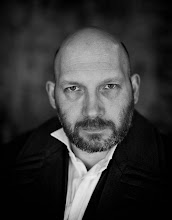
(It's been a while since I did one of these so I thought 'Why not?')
First published in 1887, Rudyard Kipling's The City of Dreadful Night is as nightmarish a little tale as you could wish to read, a macabre journey through the nocturnal city of Lahore that in some ways prefigures Magic Realism in its darkly poetic transformation of the realistic into the utterly fantastic.
Racked by sleeplessness on a stiflingly hot night, the unnamed narrator (presumably Kipling himself) choses a random direction that takes him into the walled city itself, along a highway flanked with sleeping men, to climb the Mosque of Wazir Khan in search of a cool breeze.
In terms of narrative, that's your lot, similarly character development, obstacles to be overcome or any other of the accepted ingredients in the modern short story stew, and its precisely this freedom from narrative convention that allows Kipling to paint his vivid nightmare and that gives The City of Dreadful Night its power. It is, if you like, a fantastical piece of reportage, although very firmly anchored in the reality of 19th century Lahore, taken from the skewed perspective of the chronic insomniac.
The description of a 'disused Mahomedan burial-ground', sets the tone 'where the jawless skulls and rough-butted shank-bones, heartlessly exposed by the July rains, glimmered like mother o' pearl on the rain-channelled soil. The heated air and the heavy earth had driven the very dead upward for coolness' sake.' but is only the beginning of a brief but intense phantasmagoria where sleeping men lie like 'sheeted corpses... some face downwards, arms folded, in the dust; some with clasped hands flung up above their heads; some curled up dog-wise; some thrown like limp gunny-bags over the side of the grain carts; and some bowed with their brows on their knees in the full glare of the Moon.'
Taking both its title and tone from James Thomas' poem (which itself presented a nightmarish vision of Victorian London in all its polluted, industrial glory) The City of Dreadful Night is Kipling at his most powerful, macabre image piled upon macabre image where even the simple act of a man throwing 'a jar of water over his fevered body' becomes something much more siniister - 'the tinkle of the falling water strikes faintly on the ear. Two or three other men, in far-off corners of the City of Dreadful Night, follow his example, and the water flashes like heliographic signals' and the disappearance of the moon behind a cloud heralds an even deeper sense of horror than the 'sickly warm flood of light' which had pervaded both city and story before.
While his Imperial outlook tends not to sit well with modern audiences, Kipling was nevertheless a master of mood and, like Robert Louis Stephenson before him, had the uncanny knack of being able to pick exactly the right word at the right time. You can feel the heat of the Indian night, smell the 'evil savours, animal and vegetable, that a walled city can brew in a day and a night' and feel the sense of fragmenting reality that the narrator experiences as he walks through the nocturnal streets.
As the evocation of a waking nightmare The City of Dreadful Night has few equals and its influence can be felt in such works as M. John Harrison's Viriconium, Tanith Lee's Paradys and in the more baroque elements of C.J Cherryh's Sunfall sequence. If you've never read Kipling before, or thought him merely a writer of stirring adventure stories, The City of Dreadful Night may give you a new perspective on this fascinating and often brilliant writer.


The poem of the same name was by James Thomson.
ReplyDelete